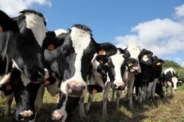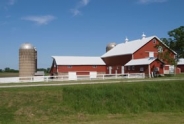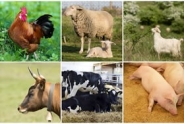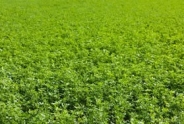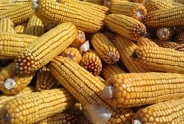Farmer Tour of Cargill Meat Solutions
Betsy Hodge, Livestock Specialist
North Country Regional Ag Team
December 29, 2016
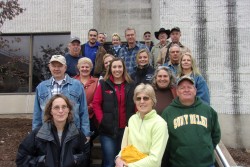
On November 16th an adventurous group of farmers and educators headed out for Binghamton, NY to stop overnight on our way to Wyalusing, PA to visit the Cargill Processing Plant. We had a caravan of cars and after picking up another person in Watertown we headed down 81.
We couldn't travel all that way and not stop at a farm! Near Homer, NY, Heather and Dennis Birdsall hosted us for a visit to their Hereford farm. They raise Hereford beef for show, breeding stock and restaurants. Fortunately they were able to purchase land around the original farm when they were starting out. This allows for a nice rotational grazing system on the hilly pasture slopes around them. Now they are hemmed in by large dairies that have bought up the land nearby. They take advantage of these big dairies to help with their cropping program.
Their cows calve in a very large open barn on a bedded pack. Calving takes place in the colder weather so the bedded pack is important to providing a dry protected place to calve. The calving is spread out over 60 days and then by carefully managing the feed and the natural size differences between the calves, they manage to have finished beef every week (or two weeks) year round for the restaurants. They have a standing appointment at a local processor that works closely with them.
Dennis and Heather met in Jr Hereford activities and are still working together. They described how they worked up from a couple registered animals and many commercial cows to a purebred herd by using purebred embryos and also using their commercial cows as surrogate mothers for others to get embryos raised. They did a great job hosting the tour and sharing ideas with us while trying to beat the rain and the dark that was closing in on us
On to Binghamton we went and were please to see several other people who met us there (including Mike Baker from Cornell and Berni Ortenzi from Adirondack Grazers). They joined us for dinner and the tour the next day. After a nice steak dinner (a necessity after hearing about all that good Hereford beef!) we settled down and agreed at leave at 7:15 am the next morning.
The next morning we were joined by a few more people including students from Morrisville and some beef farmers from southern NY. Now we really had a caravan of vehicles! We started off on time and gamely followed the GPS - only stopping once to be sure everyone was still in line.
I have to pre-face this by saying that I was not excited to go to a slaughterhouse. The thought of killing that many cows just didn't seem that appealing but I was curious about how it was being done and knew they had a good reputation. The tour, it turns out, is pretty amazing. I highly recommend it if you get a chance to go!
At the plant (which some of you will remember as Taylor Packing) we had to show ID and sign in and remove any jewelry and watches. The place looks like a shopping mall with big parking lots and low rectangular buildings. We started in the office area in a meeting room with an intro to the business. On the tour we were often on a catwalk above the operation (hence the need to remove jewelry and watches - they don't want things dropping into the food stream). Twelve hundred employees work at the plant in all sorts of capacity - from the office to the fab floor (fabrication) to shipping and handling. Most are local people and many times several members of the same family work there. They get good benefits and have a chance to move around within the plant to do different jobs.
There are 1600 cows processed there per day - 5 days a week (that's 8000 a week and over 400,000/year!!). Two thirds of them are cull dairy cows and one third are beef cattle. Five percent of their cattle come from Northern NY.
The cattle arrive at a big open barn with a high ceiling and many pens and wide alleys for sorting. They have mostly women working the cattle and they have cameras watching everything. They have a third party audit the tapes and also out on the floor making sure the animals are treated well. The animals we saw were very calm and being moved up and down the alleys in an efficient but kind manner. Slow animals are put into a pen and the USDA vet checks them. Any animal that isn't ambulatory is euthanized and goes to the rendering plant. Any meat from animals on the suspect sheet is boned and boxed separately until it passes all the tests required.
The knock box has several back-ups so there are no mistakes putting the cows down. The cows ride along on a breast rail and are just looking around calmly when they are knocked. They go from there to dressed in 20 minutes. The room where all this happens is warm and steamy and the cattle carcasses move along on a chain and workers along the way remove the hide and the organs. Inspectors look at the organs on a conveyer belt. It was obvious they were checking the livers and spreading out the other organs and looking thru them.
There really isn't any hang time. The cattle are pretty much processed right away. They make 350,000 pounds of ground beef per day. We saw the grinders and saw how they mix and package the finished product. Some is in bulk and some is in case ready trays. There are cardboard boxes everywhere being loaded with cuts and ground. Meat and boxes are moving everywhere quickly.
On the fabrication floor the different cuts are trimmed and portioned and packaged. It's cold in there and everyone is wearing white. People are lined up along white tables with conveyers running above them and bins under holes in the tables. Employees are skilled and trim and sort the products at an amazing speed. They rotate to different jobs during the day so that they don't get sore from standing in one place and doing repetitive movements. There is a steady rhythmic noise and hum and lots of movement. I wish I could have taken pictures to share. It kind of reminded me of an old black and white cartoon of a factory or Santa's workshops where the elves are all working in a rhythm.
Cuts are packaged mostly by machines or people aided by machines. Tenderloins slide down a shiny metal tube into plastic sleeves that are shrunk onto the meat and labeled and boxed at a rapid pace. People were handling the sleeves and packing the boxes and doing some sorting as they worked.
Nothing is wasted. Bones are shuttled to a room where people with special circular, spinning knives peel off any scraps they can find on the bones. The scraps are collected and ground and go into the ground beef mixes. Bones are made into bone meal and blood into blood meal. The equipment in the plant is pretty amazing. It's large, stainless steel and very specialized. Stuff goes in the top and something else comes out the other end all packaged or ground or sorted or whatever that machine is supposed to do. There are many people there monitoring the whole system as well.
Boxes are going to cold storage and many are moved out that day. There are small forklift type vehicles moving along marked paths on the floor. And I mean they are moving. It takes a lot of coordination to move that much product that quickly and keep it all safe and organized.
Speaking of safety, everyone we saw had eye protection, ear plugs, white coats, etc. The plant has their own crew that comes in and cleans after the 8 hour shift of processing cattle. The cleaning takes another 8 hours.
The staff mentioned that injection site blemishes are one of their biggest concerns and causes the most waste. They ask that producers do a good job with record keeping and do injections in the neck and subQ whenever possible.
They prefer cattle under 2000 pounds. Their buyers are on the road and buying at the local auctions as well as doing some direct buying from larger farms. All animals are identified and the meat is traceable back to the farm. It is tracked through the plant with RFID.
The plant packages most of its meet under the Circle T label that comes from the old Taylor Packing. We saw many packages that were labeled with Excel and they do package meat for other labels like Meyer and Strauss. There is no sausage or other added ingredient or cooked products made in the main plant.
The staff was very willing to answer our questions before and after the tour. I think they enjoyed talking to a bunch of farmers from the other end of the business. I know we enjoyed the tour and the good conversations during the drive down and back.
Announcements
No announcements at this time.

